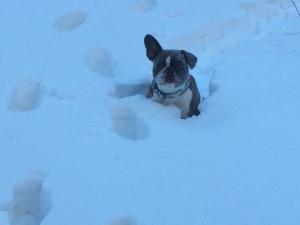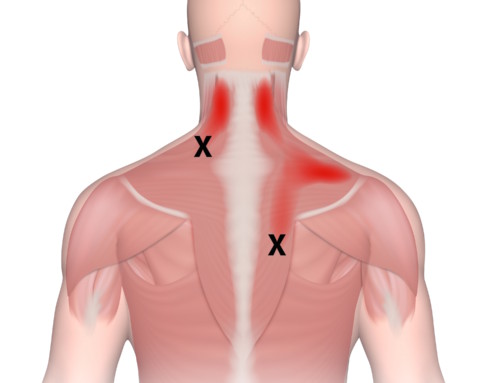Running In The Snow Is Hard Work.

Rory loves snow. We have not yet determined whether she loves acupuncture.
When the temperature drops and the snow starts falling, I start to see some specific injuries directly related to running on ice and snow. But why, exactly, does winter running confer a different set of injury risks?
- WINTER IS COLD. A tight, cold muscle that is required to contract at high intensity is particularly vulnerable to injury.
- Running on ice and snow places significant demands on a completely different set of muscles than you use on clear trails and roads.
- ICE (need I say more?)
Running in snow is exhausting. Anyone who’s run in the snow has certainly had the experience of working really, really hard and essentially getting nowhere. As it turns out, a lot of that extra work is being performed by a completely different set of muscles than you normally use. Running on clear roads and trails strengthens the muscles that propel you forward, while winter running forces you to recruit the muscles that stabilize medial, lateral, and rotational movement.
Basically, you spend the whole year running as fast as you can in a straight line, and come winter you are faced with wildly uneven surfaces that require a number of compensations in the body. Here are the muscles most likely to be victims of winter running, and what to do about them.
Overuse
The peroneal muscles and the posterior tibialis take a lot of abuse during snow-running because they frequently function to control movement rather than to produce it. Running on uneven surfaces elicits a number of twists, rotations, and lateral shifts in your foot strike. These rotational forces travel up the body and are absorbed by the muscles that stabilize the foot medially (posterior tibialis) and laterally (peroneus longus and brevis). For instance, running in divets in the snow created by other people’s footprints can cause your foot to pronate violently, which acutely loads the posterior tibialis. If, on impact, your ankle rolls to the outside, the peroneals engage to control that lateral movement. Not a huge deal if this happens a few times on a run, but if this violent foot inversion/eversion is repeated over the course of a number of miles on muscles not used to that kind of load, then you get an injury.
Slipping on Ice
The muscles of the adductor group (magnus, longus, brevis, gracilis) are commonly injured by slipping on ice. As your legs slide out from under you, any one of these can become acutely overloaded as you try to maintain balance and keep from falling. This can result in painful trigger points, a strain, or even a tear.
Prevention and Treatment Tips
Mileage counts more. Trying to maintain the same mileage volume in the snow as you do on clear surfaces is a recipe for disaster, particularly if you already have lower leg instability issues. Alternate snow running with mileage on clear trails and roads. Or here’s an idea: try another winter sport other than running to give those stabilizers a break.
Unstable levers cannot tolerate high loads. Strengthening the stabilizers of your lower leg will make them more resilient to the increased demands of snow running. Strengthen these muscles directly with resisted foot inversion and eversion (resistance bands work great here.) Glute strengthening exercises increase stability in your hips, which in turn will help minimize rotation of the lower leg.
Ice Happens. Wear Traction. Microspikes, screws in your shoes, yak tracks, crampons, SOMETHING.
HEAT, HEAT, HEAT. If you have an injury that seems to be worse in the cold, take extra precautions by warming up indoors and applying a warming liniment or kinesiotape to the area before heading out in the cold.
GET SOME ACUPUNCTURE
If you do find yourself with an injury after some fun excursions in the snow, chances are you have acquired some trigger points due to overloading one or more of the muscles mentioned above. Acupuncture is the most effective way to release these muscles; stretching is simply not sufficient. A single needle achieves a deeper release with greater precision than any amount of massage or stretching to the area. Acupuncture can speed the healing of muscle strains, and it can also facilitate muscles that have become inhibited and are not functioning fully.







